Wasps are one of the most common stinging insects that pop up in your garden as soon as spring arrives, wasps are pesky little bugs that can cause both physical and mental pain to homeowners.
So how long do these troublemakers live?
The life expectancy of wasps mostly varies between species, as well as gender and caste.
As a general rule female social wasps will live between 12 – 22 days with males living slightly longer. Queen wasps hibernate in winter living for up to a year. Solitary wasps pupate over winter emerging in spring as adults they live for 3 to 6 weeks with male wasps dying soon after mating.
We’ll take a closer look into the life cycle of the wasp, how and why genders and classes live different amounts of time, and what it is that causes wasps to die. So, stick around to learn more about the lifespan of these pesky intruders.
The Life Cycle Of A Wasp
The life cycle of a wasp is similar to that of a honey bee. Although the time periods between the two species differ, the caste system remains the same.
All wasp colonies are arranged with the same system: A single fertile egg-laying queen, sterile female workers, and male drones.
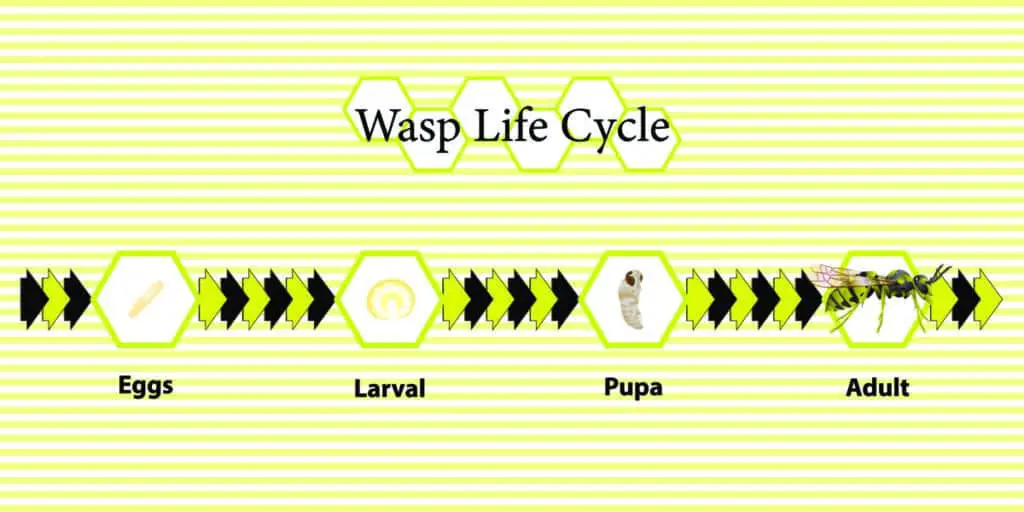
The lifecycle of a wasp colony begins in spring when the queen emerges from hibernation and ends in winter with the death of the colony queen.
The Start Of The Wasp Colony (Spring)
The fertile queen wasps emerge from their winter hibernation and go in search of a suitable area to start their own nest.
Once the queen has found a suitable spot for her nest, she will build a few cells and lay her first set of worker wasp eggs.
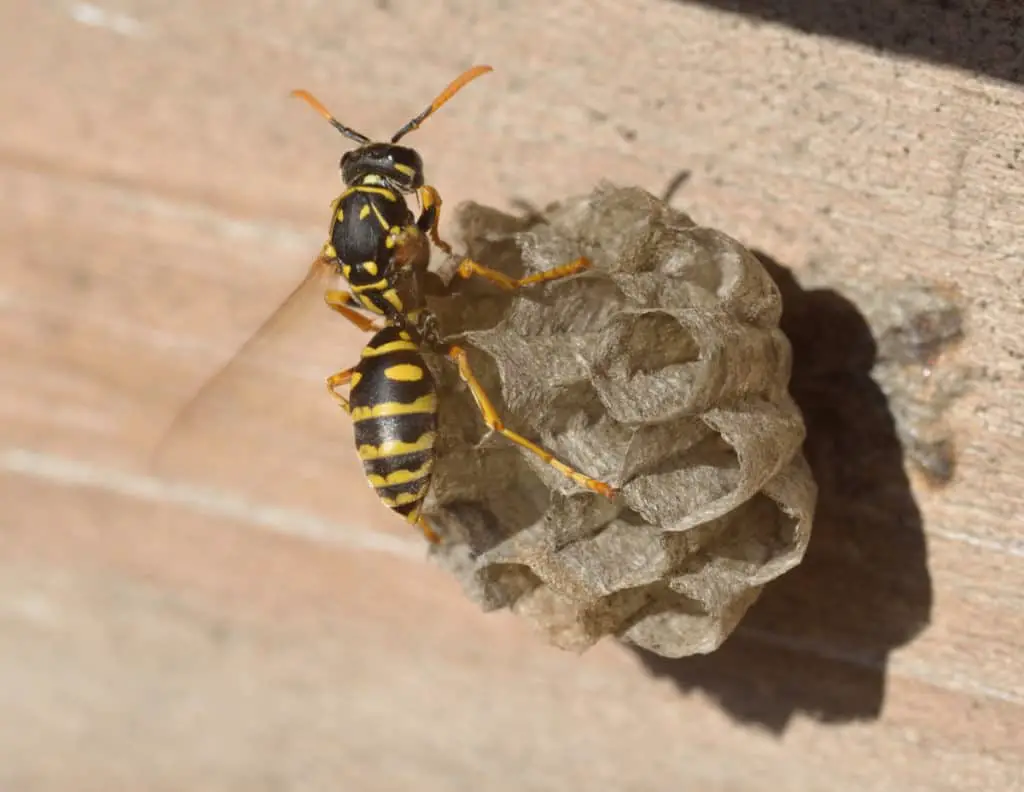
After the eggs have hatched, the female workers take over the job of building the nest, foraging for food, and caring for the young.
Once the worker wasps have taken control of the hive’s maintenance, the queen becomes a full-time egg layer, laying between 100 and 300 eggs per day.
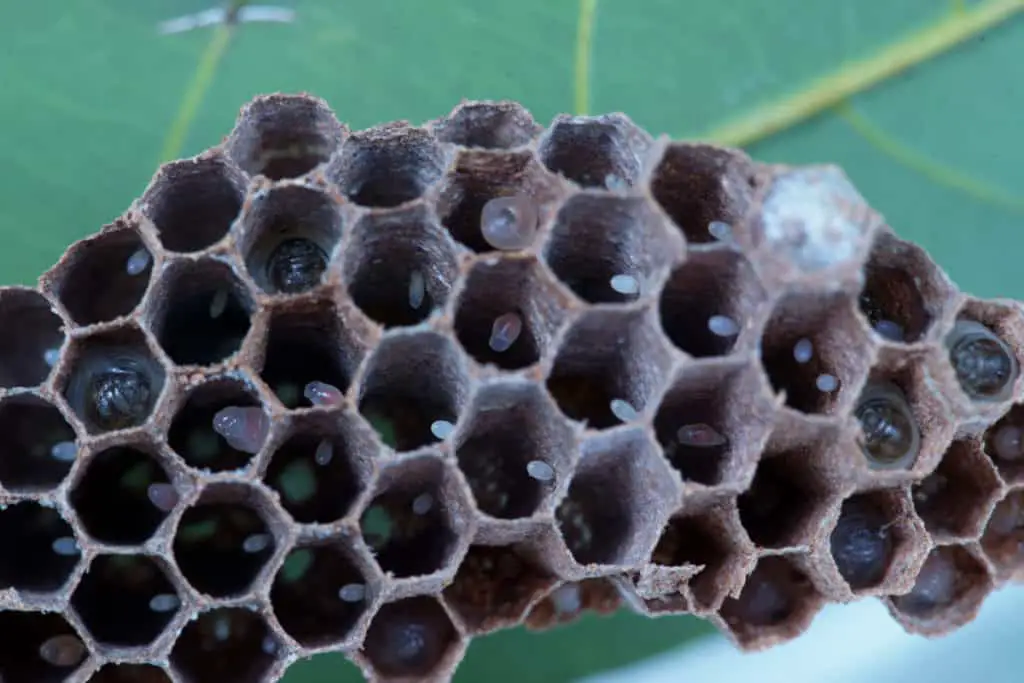
The Expansion Of The Colony (Summer)
During the summer the colony is at its most productive and in full swing. The size of the nest between late spring and late summer often doubles in numbers, going from 5,000 to 10,000 wasps.
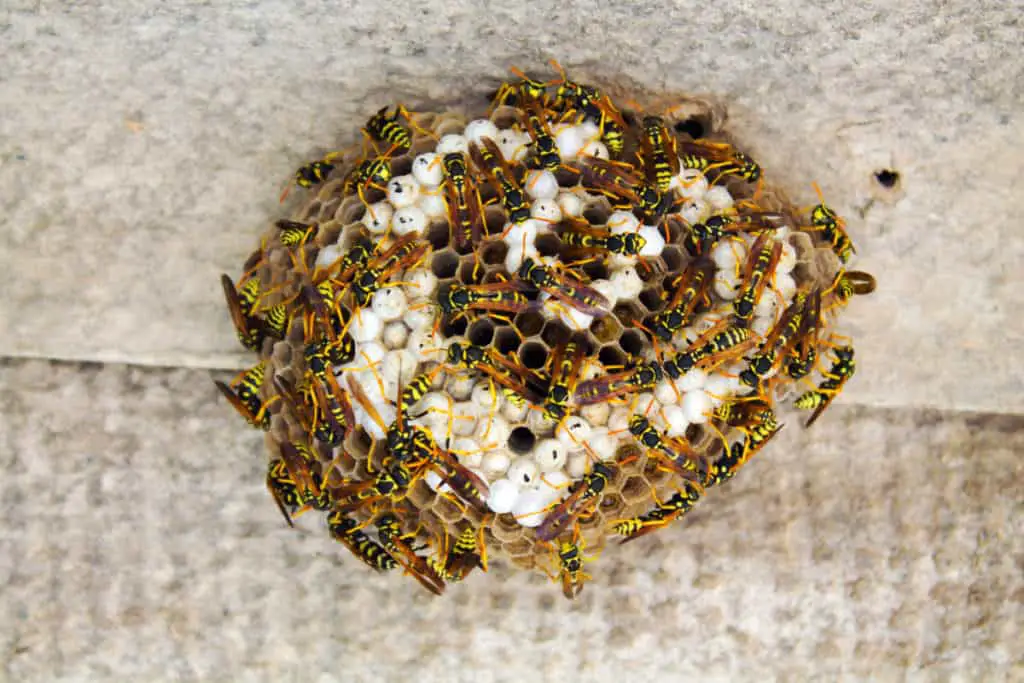
Towards the end of summer, the size of the colony has hit a peak. It is at this time that the queen wasp begins to lay new queen wasp eggs and fertile males.
The End Of The Colony (Autumn)
Unlike honeybees who have hives to help them survive the winter, wasps nests are typically exposed to the elements.
As temperatures begin to drop, life within the colony begins to break down.
The queen stops producing pheromones that keep the nest functioning and the remaining wasps lose their functions within the colony.
The newly emerged queens will leave the nest in search of a mate to fertilize their eggs before the coming hibernation over winter.
Fertile males will also leave the nest at this time, in search of a virgin queen. Male wasps will die shortly after mating, and those that do not mate will die as temperatures drop.
The Colony Dies Out (Winter)
Towards the end of fall and beginning of winter (depending on the local climate) the entire wasp colony will die out, excluding the new queens which are now in hibernation.
The Expected Lifespan Of Common Wasp Species
Different castes of wasp have different life expectancies.
To better understand why the different castes within a social wasp colony have different life expectancies, we will briefly discuss the purpose of the different castes which brings an understanding to how long they live.
Female Worker Wasps
The unfertilized females (worker wasps), similar to those of the honey bee, have the shortest life span within the colony. Living between 12 and 22 days on average in the wild, these workers tend to have a short lifespan because of their active lifestyle and adventurous ways.
When the females freshly emerge as adults, they remain in the nest for a few days, with the task of feeding and caring for the pupae.
After this period, their job is to take on the construction of the nest. Flying out every day, the worker wasp will collect water and wood fiber to contribute to the expansion of the nest.
The third task that female wasps will undergo is to forage for food. Most workers will find food within a few hundred meters of the colony, although in some cases they will travel further.
After a period of foraging for food, the workers’ final job, which will take them to the end of their life cycle, is to return to the nest where they will remain until they die with the purpose of protection.
Workers nearly never survive for longer than three months in the wild, although studies conducted in controlled environments have recorded workers living for over 100 days.
Male Drone Wasps
Male drones only show up near the end of summer and stick around until mid-autumn. These fertile males have only one purpose, reproduction.
They don’t have a function within the colony and stay in the nest for a period of time before being kicked out by the worker wasps. That being said, some studies have found that in the absence of female workers, the males will take up the task of protecting the nest.
Although this may seem as though the drones have a connection to the colony, it is believed that these acts of defense are purely out of self-interest, and in the case of a single female wasp, the male drones would give up on the task.
Once the drones have been kicked out of the colony, they gather, usually in the tops of a tree, and wait for the opportunity to mate with a female. Eggs for drones are generally laid two weeks before the first queen, and therefore the period of waiting can span up to 4 weeks in some cases.
As males do not have any purpose other than fertilization, they usually die shortly after mating with a queen. Unmated males will live slightly longer but will die as winter rolls in, either from the cold or from starvation.
Queen Wasps
The queen wasp, in most cases, lives the longest out of the three castes. They hibernate over winter and are expected to lay eggs until the following fall. So they generally live for up to 12 months.
Once the queen has established a nest and produced a few workers, she will not leave the colony until she dies. Worker wasps will feed and care for her until the stage that she can no longer produce eggs.
Expected Life Span Of Solitary Wasps
Solitary wasps, unlike their social cousins, have a slightly different life cycle. There is no caste system, only females and males.
Another thing that differs between the species is that the females do not hibernate over winter. The pupae hibernate in most solitary wasp species, thus increasing the lifespan of both males and females.
Solitary wasps emerge from their hibernation as adults at the start of spring. From here the females go in search of a new spot for a suitable nest, while the males go in search of a suitable female.
Similar to social wasps, in some solitary wasp species, the male dies shortly after mating. However, there are some exceptions, such as the Mud dauber, who often remains alive and protects the nest from other males and predators.
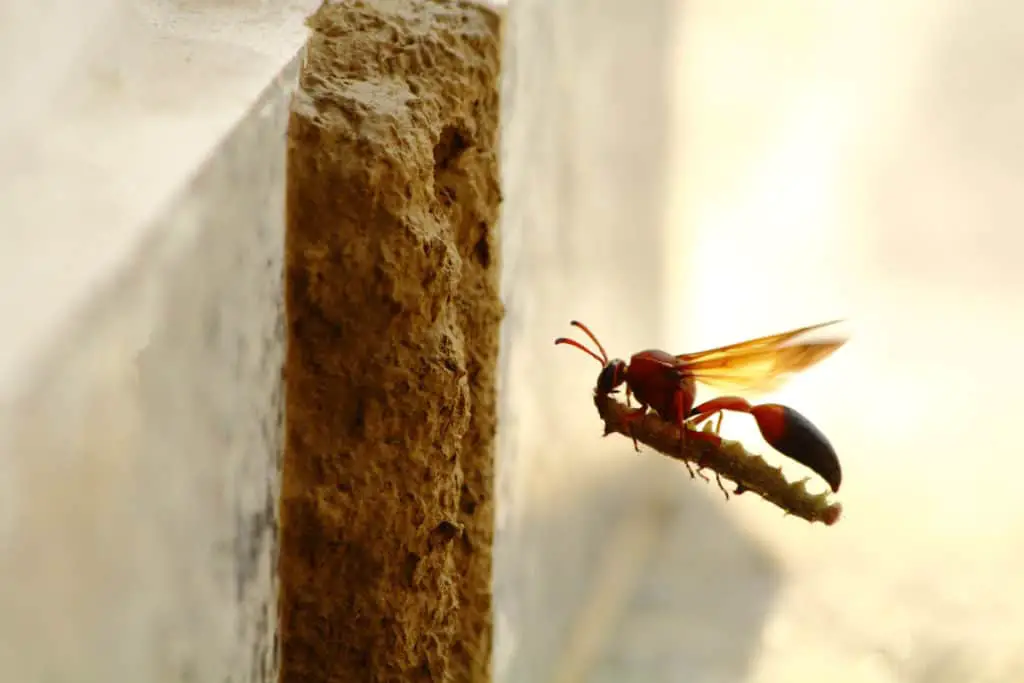
Species where the male doesn’t die after mating, live for the season (typically 3 – 6 weeks), where both the males and females will die.
Once again, there is an exception to the rule when it comes to the organ pipe mud dauber, as some overwinter as larvae, but others overwinter as adults and begin the reproductive cycle during the following spring.
Do Male And Female Wasps Live Different Lengths?
Male and female wasps generally have different life spans. In social species, female wasps live the longest, however, it is only the queen that enjoys this privilege.
Male drones and female workers live approximately the same, however, it is common for the males to live slightly longer.
As for solitary species, in some species, the male wasp only lives for a few weeks, or up until it has mated, while in other species the males and females will both live throughout the season.
Why Do Wasps Die?
While wasps have an expected life cycle, several factors contribute to them dying sooner. Some of these include but are not limited to predators, interspecies conflict, food availability, the climate, and human intervention.
Wasp Predators
Although wasps are often thought of as killing machines, they are also prey.
Most animals prefer to feed on the larvae of a wasp, however, animals such as praying mantis, dragonflies, moths, starlings, magpies, and some beetles, to name a few, are often recorded hunting adult wasps.
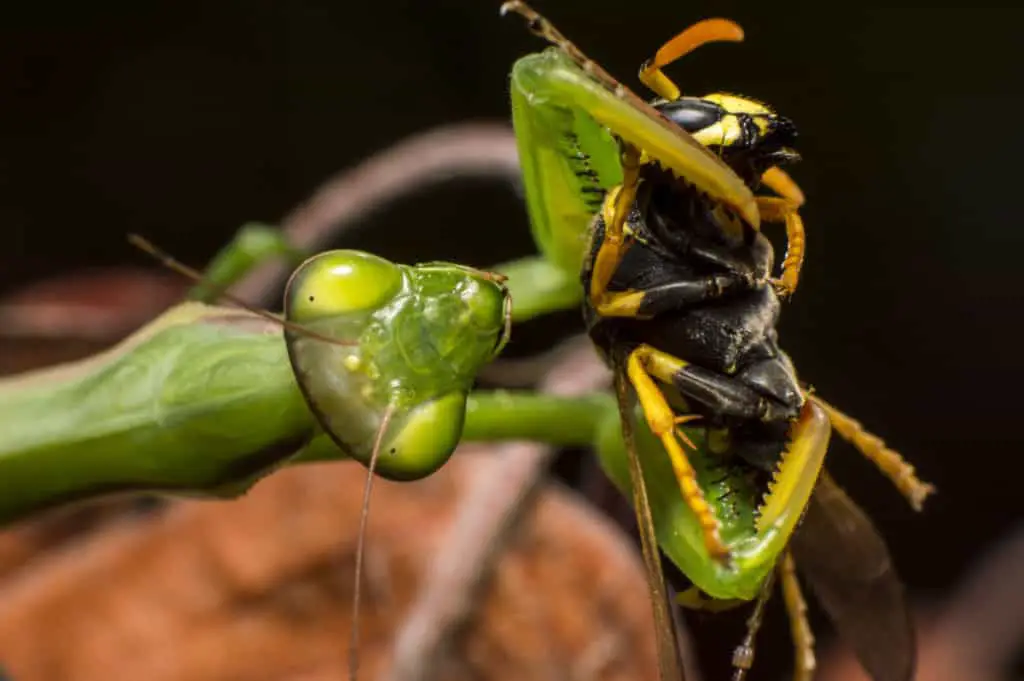
Mammals such as mice, skunks, raccoons, and badgers are brave enough to attract wasp nests directly in search of the larvae to feed upon.
Interspecies Conflict
Wasps not only fight off predators but in some species they are known to fight each other, often to the death.
The males of the parasitoid wasp are known to engage in fights to the death over the right to mate with females. These fights can occur whether they have already mated, or even with male wasps from their own nest.
Some solitary wasps, such as the cleptoparasitic wasp is known for home invasion. Other solitary wasps often need to defend their nests and larvae from being stolen by a cleptoparasitic wasp. These fights often result in the death of one of the two wasps.
Similarly, species such as the giant killer hornet launch full colony vs colony sieges when resources become scarce. In the following video, the rivalry between the two colonies can be observed.
If you are interested in comparing some of the common species of wasps check out the links below to the article we have written:
The Availability Of Food
Most wasp colonies tend to die as the winter months approach, but in most cases, it is not the cold that kills them off, it is starvation.
Adult wasps feed on sugars from plants and flowers. Some species of wasps will even feed on meat. As these are scarce in the winter season, the wasps no longer have a food source.
The Climate
While it is not the cold that directly kills off wasps, it still plays a major role in determining the lifespan. In places where summer and winter temperatures differ greatly, A wasp provided with enough food over the winter months, it’s still likely to freeze to death.
The biggest killer of wasp colonies is the changing of the season, and as mentioned above, how the seasons limit food availability.
On the opposite side, the increase in global temperatures, and reduced rainfall have created a positive effect within wasp species, where the colonies grow faster and survive longer.
If you are interested we have written an entire article where we dig deep into this topic. The article is called, What Temperature Do Wasps Die At?
Human Intervention
Wasps certainly are not a favorite for most people for two reasons in particular:
- Wasps have the potential of giving a nasty sting (although most species are not aggressive)
- damage structures, as it is with horntail or wood wasps
Because of this animosity, destroying their nests or removing insects by pesticides is a common practice.
Although killing a single worker wasp will not affect the colony, destroying a wasp nest will lead to the complete collapse of that colony.
Adult wasps feed on sugars produced by aphids on plants and flowers. Wide-ranged pesticides have the potential of killing wasps without discrimination.
Furthermore, a general insect killer could lead to the death of a colony as worker wasps could feed the young with poisoned prey.
The Wrap Up
The lifespan of a wasp greatly differs between species and the wasps cast within a colony.
Generally speaking, within a social wasp colony, the female workers live between 12 – 22 days, and the male drones slightly longer.
Social queens can live up to 12 months as they will hibernate over winter.
Solitary wasps slightly differ as in many species, both the male and females will live out the season, and in some cases, hibernate overwinter as adults.
If you are interested we have written a bunch of other articles that cover the life cycles of other bugs. Check out the links below:
How Long Do Spiders Live? One Species Can Live For Decades
How Long Do Grasshoppers Live?
Sources
https://www.wasp-removal.com/wasp-lifecycle.php
https://www.ncbi.nlm.nih.gov/pmc/articles/PMC4375972/
https://phys.org/news/2011-04-male-wasps-defend.html
https://nature.mdc.mo.gov/discover-nature/field-guide/mud-daubers
https://insectcop.net/wasp-life-cycle-lifespan/
https://sciencing.com/natural-predators-of-wasps-12298866.html
https://phys.org/news/2011-08-mortal-combat-rational-choice-wasps.html
https://link.springer.com/article/10.1007/BF01054524
https://journals.plos.org/plosone/article?id=10.1371/journal.pone.0027004
https://www.sciencedirect.com/science/article/abs/pii/0304400983900323
